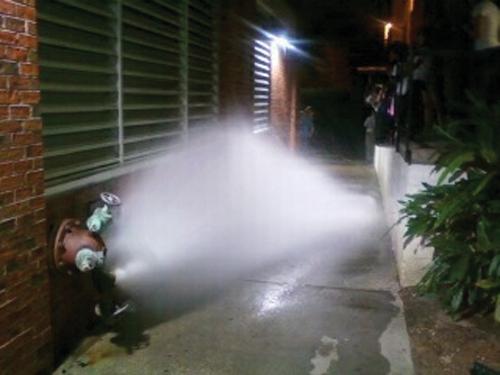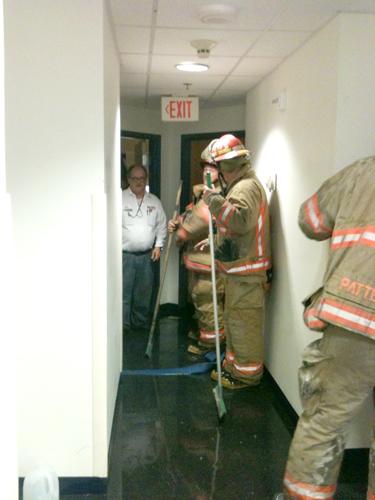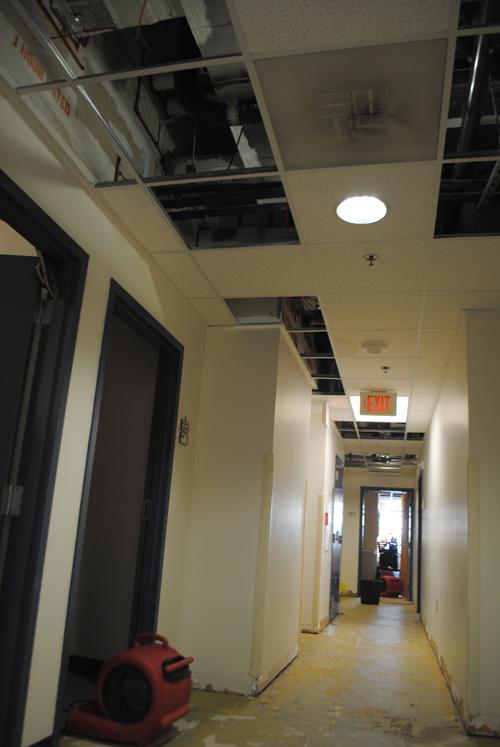The Carrollton Hall flood proved the university’s life systems—sprinklers and fire alarms—serve as more than mere ceiling and wall decoration.
On the night of March 23, a fire alarm was set off at 12:27 a.m., and students had to evacuate Carrollton Hall for the night.
The alarm went off due to a broken sprinkler on the sixth floor.
According to Roger Pinac, University Police captain, once the sprinkler was set off, a notification was sent to the university’s offsite alarm monitoring company, as well as the Loyola University Police Department.
The alarm company notified the fire department that a sprinkler went off, resulting in four fire trucks arriving minutes later.
After the broken sprinkler was capped, power in the building was shut off at roughly 1:15 a.m., until generators were turned on approximately 30 minutes later.
Amy Boyle, associate director of Residential Life, said the fire marshal ordered the electricity to be turned off to avoid fire hazards.
By 2 a.m., Physical Plant and WFF employees were cleaning the building and by 6 a.m., an outside contractor arrived to fix more damages.
The building reopened hours later, at 1 p.m.
“We had to verify that both systems were in operation before we could occupy the building,” said Ann Moss, director of facilities operations for Physical Plant, regarding the sprinkler and alarm systems.
“Because if they weren’t and another incident happened, obviously we wouldn’t be covered with our life safety,” Moss said.
Students were then able to see if there was any damage in their room.
According to Moss, at least two rooms and part of the fifth floor hallway needed carpet replaced.
Residential Life has been working with students on a case-by-case basis, according to Amy Boyle, associate director of Residential Life.
They ask that students cooperate with recommendations—such as keeping blowers on, keeping windows closed, and cleaning and drying wet materials.
“We’re going to work with people as best as we can,” Boyle said.
Physical Plant is assessing the damages caused to the building. Smoke detectors and the broken sprinkler, along with the carpet, had to be replaced.
The use of wet vacuums and blowers will also be included in total damage costs.
Because carpet in the building is still being dried, the cost of damages for the building has yet to be determined.
The university or its insurance company will cover the costs of damages to the building.
The incident has been positive in that it has encouraged the university to create a more concrete emergency plan.
Hypothetically speaking, if students were displaced longer, Boyle said they might have stayed in open rooms on campus or in hotels.
“We need to create a more finalized plan in the future,” she said.
In the meantime, officials know systems are working properly.
“At least everyone has the peace of mind that everything works the way it’s supposed to work,” Pinac said.
According to Patrick Bailey, Loyola University Police Dpartment chief, the students responsible for breaking the sprinkler sought out officials and confessed. No charges against the responsible parties will be pursued.
“For a crime to be committed, there has to be criminal intent,” said Bailey. Since there was no criminal intent, there was no crime.
The matter has been sent to Student Affairs.
Precious Esie can be reached at
piesie@loyno.edu

Water sprays from the hydrant outside of Carrollton Hall next to the Danna Student Center when a sprinkler was broken on the sixth floor. Residents had to evacuate the building from around 12 (Precious Esie/The Maroon)

Firefighters clean the water that leaked from the sixth floor to the fifth floor of Carrollton Hall, on March 24. A fire sprinkler was triggered by a lacrosse ball thrown in the apartment 601. More photos are available online. (Julia Russler/The Maroon)

The carpet on Carrollton’s fifth floor is pulled up. It will not be replaced until dry. (Julia Russler/The Maroon)






